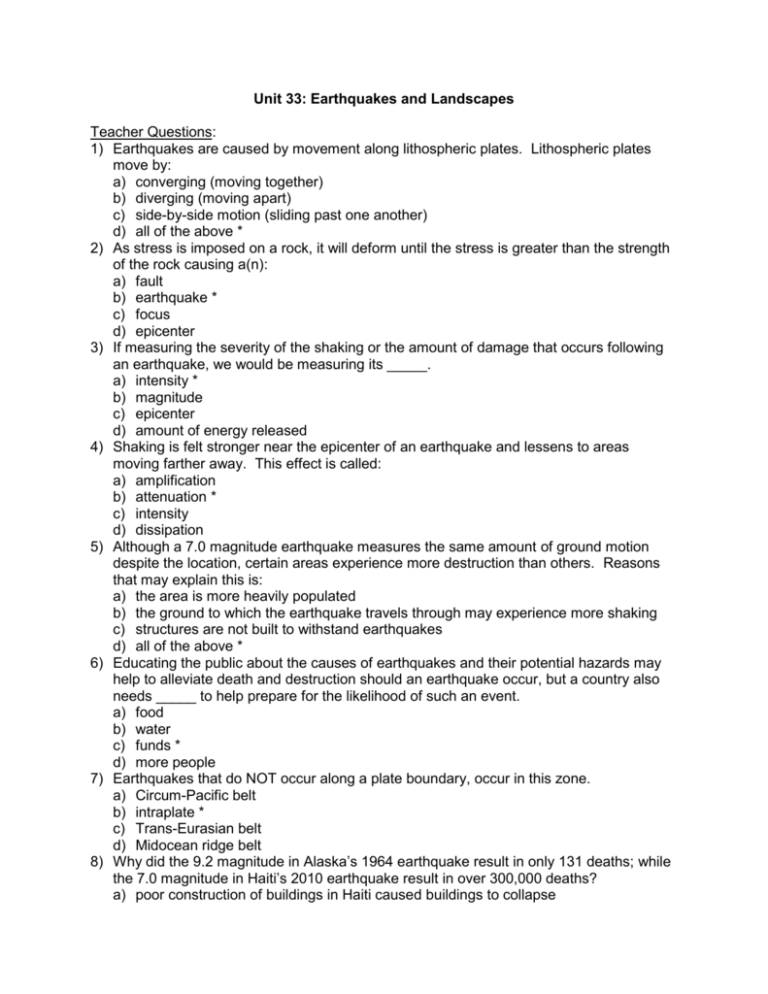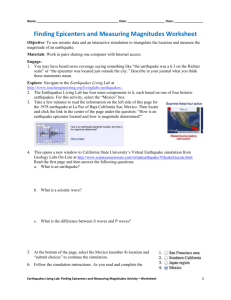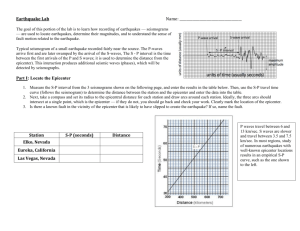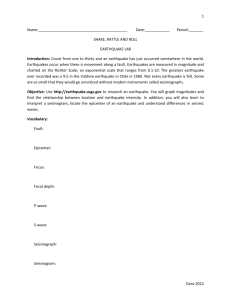33 - Cal State LA - Instructional Web Server
advertisement

Unit 33: Earthquakes and Landscapes Teacher Questions: 1) Earthquakes are caused by movement along lithospheric plates. Lithospheric plates move by: a) converging (moving together) b) diverging (moving apart) c) side-by-side motion (sliding past one another) d) all of the above * 2) As stress is imposed on a rock, it will deform until the stress is greater than the strength of the rock causing a(n): a) fault b) earthquake * c) focus d) epicenter 3) If measuring the severity of the shaking or the amount of damage that occurs following an earthquake, we would be measuring its _____. a) intensity * b) magnitude c) epicenter d) amount of energy released 4) Shaking is felt stronger near the epicenter of an earthquake and lessens to areas moving farther away. This effect is called: a) amplification b) attenuation * c) intensity d) dissipation 5) Although a 7.0 magnitude earthquake measures the same amount of ground motion despite the location, certain areas experience more destruction than others. Reasons that may explain this is: a) the area is more heavily populated b) the ground to which the earthquake travels through may experience more shaking c) structures are not built to withstand earthquakes d) all of the above * 6) Educating the public about the causes of earthquakes and their potential hazards may help to alleviate death and destruction should an earthquake occur, but a country also needs _____ to help prepare for the likelihood of such an event. a) food b) water c) funds * d) more people 7) Earthquakes that do NOT occur along a plate boundary, occur in this zone. a) Circum-Pacific belt b) intraplate * c) Trans-Eurasian belt d) Midocean ridge belt 8) Why did the 9.2 magnitude in Alaska’s 1964 earthquake result in only 131 deaths; while the 7.0 magnitude in Haiti’s 2010 earthquake result in over 300,000 deaths? a) poor construction of buildings in Haiti caused buildings to collapse b) because Alaska is built on loose sediment and buildings moved with the shaking c) because of low population density near the epicenter in Alaska’s earthquake d) both (a) and (c) * 9) The largest recorded earthquakes that have been recorded typically occur along: a) divergent boundaries b) convergent boundaries * c) strike-slip boundaries d) all of the above 10) Subduction zones are associated with this type of plate boundary. a) divergent boundaries b) convergent boundaries * c) strike-slip boundaries d) all of the above 11) A tsunami wave is also correctly called a; a) seismic sea wave * b) tidal wave c) volcano wave d) both (a) and (b) 12) All of the following are possible causes of a tsunami EXCEPT: a) Earthquake b) volcano c) landslide d) earth-moon gravitational pull *











